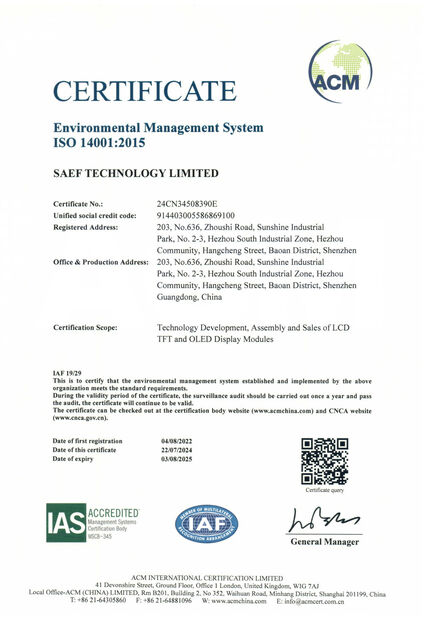Revisões do cliente
Resposta muito rápida ao e-mail e após o pagamento o item validado foi enviado com frete aéreo expresso e recebido em poucos dias.Os itens eram novos e em boas condições e até tinham a cabeça do alfinete soldado, o que é um grande plus.Muito feliz em geral e comprarei de novo!
—— Andreas Anderssons
Como sempre, 100% melhor serviço...
—— Evto-WEb Aps. Dinamarca
A tela é brilhante! Trabalhou como esperado usando as bibliotecas do Adafruit mencionado em outras revisões. Também deve usar a configuração SPI_MODE3 no Init. Eu usei o Arduino Nano, VCC para 5V e BKL para 3.3V. (PN: SFTM130JY-7181AN)
—— Richard Ingram
É em linha reta acima do monitor de HDMI com Micro-USB para controles do poder e do toque. É um truque extravagante é que ele é um monitor (capacitivo) do toque de 5 pontos assim que trabalha apenas como um telefone ou uma tela do portátil com torneiras, arrastos, pitadas e outros gestos do toque. Quando em modo prolongado comutado a suas definições nativas e à exposição era agradável e afiado.
—— Darkwynd
Olá, Janco.
Espero que estejas bem.
Ficamos muito satisfeitos com a qualidade do lote anterior de OLED de 2,42 polegadas que trouxemos de vocês (veja abaixo).
Gostaríamos de fazer outro pedido para XXXX peças.
—— Libby.
Eu tenho este estabeleço-me um monitor para um sistema de segurança. Trabalha grande depois que eu fiz alguma pesquisa de defeitos.
—— Michael Helms
Trabalho excelente! Obrigado
Eu manterei sua empresa no contato para o。 seguinte das ordens
—— DEMAC S.A.
Em geral um grande monitor. Eu sou um guerreiro da estrada e olhava um monitor portátil que eu poderia tomar comigo para fazer meu trabalho mais eficiente. Total impresso com o produto. A tela olha boa, é responsiva, e as cores/agudeza são boas.
—— J Rau
Monitor pequeno impressionante para meus projetos.
—— Daniel Champagne
Recebi as amostras dentro de uma semana. Entrega muito rápida. Esta é uma tela muito bonita. Muito nítida com bom contraste. Os ângulos de visão são um pouco melhores do que algumas das outras telas que eu usei.
—— George B.
Os monitores vieram bem embalados com espuma para proteger os pinos de cabeçalho contra ser dobrado na remessa.Cabeçalho pré-soldado é uma economia de tempo. espaço suficiente para quatro linhas por dezesseis caracteres de texto minúsculo.
—— Isto.
É muito fácil de configurar, e boas cores. Preto puro é perfeito, como esperado de um OLED. O único problema que tenho é a escrita por pixel - leva cerca de 1,5 segundos para uma atualização completa com a minha configuração.
—— Ryan James
Grandes ecrãs - estavam bem embalados e funcionaram muito bem!
—— Fletcher.
Esta não é a primeira vez que encomendamos. Primeiro, encomendamos um lote de teste de 10 peças, depois duas vezes de 1000 peças, e agora 3000 peças.
—— Josh
Olá, Christina.
O produto que encomendámos, o ecrã OLED de 3,12 polegadas, foi testado e funcionou perfeitamente, 100%.
Estamos muito satisfeitos com o produto, o envio rápido e o excelente serviço ao cliente.
Os melhores cumprimentos.
Andreas.
—— Andreas Anderssons
Estou a trabalhar no sistema de entretenimento móvel de código aberto Reflections e precisava de um ecrã brilhante para uma aplicação de relógio de pulso.e enviou-me as peças rapidamente.- Frank.
—— franco
É um bom produto. es el equipo de profesionales que tiene esta empresa que responden de forma muy profesional y amable a cualquier reto que se presenta para la puesta en marcha y desarrollo de los proyectos que se realizan con estas pantallasMuito obrigado por tudo.
—— Eric M.
Um prazer trabalhar com esta empresa. profissional, rápido e direto ao ponto durante todo o processo.
—— Joseph Woodcock
Perfeito, obrigado!
—— William Klein
Os cuidados do fornecedor foram excelentes desde o primeiro dia.
—— Peter Franzke
Qualidade excelente
—— Tisagh Chase
Esta foi a nossa primeira vez aqui, foi um processo suave e fácil, não será a nossa última encomenda.
—— Jordânia L
Satisfeito muito
—— - Jeff.
Estes chegaram a tempo e a qualidade foi incrível.
—— Niccolò
Pessoas simpáticas, muito úteis.
—— Valentino.
Muito bom LCD e imagem muito clara.
—— Charlotte.
A qualidade do produto foi como esperado. Muito recomendado e fornecedor é muito rápido em responder às perguntas.
—— Elissa Decker
A tela é exatamente como descrito, com alta resolução, brilho e uma pequena placa HDMI que funciona perfeitamente.
—— Virtuário
O produto foi recebido a tempo e sem qualquer dano.
—— Brooke.
Produtos excelentes, o fornecedor é muito atencioso, pedimos mais 2500.
—— Gao Vang
Parte do pagamento foi sobre o carregamento e foi recebido a tempo.
—— Stephanie Jade
O fornecedor foi muito útil e o item chegou imediatamente.
—— Staci
Este fornecedor encontrou a melhor solução que atende aos nossos requisitos.
—— Alex Bowers
Óptimo produto, parece fantástico.
—— - Nick.
Muito bom apoio
—— Taylor D. Fussell
Os ecrãs funcionam como esperado, boa embalagem e rápido envio.
—— Ginnart
O produto é bom e estamos a procurar este fornecedor, é o nosso principal fornecedor de ecrãs.
—— sara
Os fornecedores qualificados, com bons prazos de entrega e boa qualidade, continuarão a cooperar.
—— José Sánchez
Excelente qualidade e entrega rápida.
—— Maliboogal
Olá Cologne, obrigado pelo seu feedback agradável, sim, Windows tudo em uma tela sensível ao toque, nós padrão 2.4G wifi apenas, Se precisar de BT e 5G wifi, precisa me dizer com antecedência. Desejando-lhe tudo de bom ~
—— Frederick Brown
Bom vendedor, recebo sempre uma tela de boa qualidade.
—— Joachim Wandji

 Por favor verifique seu email!
Por favor verifique seu email! Por favor verifique seu email!
Por favor verifique seu email!  Por favor verifique seu email!
Por favor verifique seu email! Por favor verifique seu email!
Por favor verifique seu email! 

